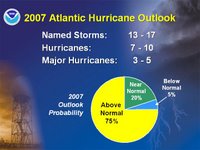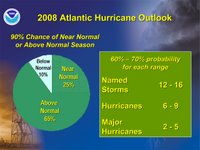07 Jul 2008 In Making Hurricane Predictions, NOAA Aims for Broadside of a Barn
With the news today of the formation of the first Atlantic hurricane of the 2008 season, David Ridenour comments on NOAA’s 2008 Atlantic hurricane forecast:
NOAA may have finally figured out a way to get its Atlantic hurricane forecast right. It’s predicting that the 2008 season, which began June 1, will be either normal or above normal.
Covering two out of three possible outcomes ought to improve NOAA’s odds quite a bit.
After bungling its Atlantic hurricane forecasts badly both last year and in 2006, NOAA is no doubt anxious to avoid being embarrassed for the third year in a row. Last year, NOAA forecast seven-to-nine hurricanes (17%-50% above normal), but there were just six hurricanes, the number NOAA considers normal. In 2006, the agency also forecast seven-to-nine hurricanes and came up two short of its low-range estimate.
The difference in the way NOAA is making its prediction this year appears especially stark when you compare NOAA’s 2007 and 2008 graphs. In its 2007 hurricane-prediction graph, NOAA represented normal, above normal and below normal by different colors.

The 2008 hurricane-prediction graph has just two colors — green for both near-normal and above-normal and light blue for below normal.

Microsoft PowerPoint – press conference slides_may2008_FINAL
Here’s how NOAA explains it in its press release:
The Climate Prediction Center outlook calls for considerable activity with a 65 percent probability of an above normal season and a 25 percent probability of a near normal season. This means there is a 90 percent chance of a near or above normal season.
Funny, NOAA personnel didn’t do it that way last year:
Experts at the NOAA Climate Prediction Center are projecting a 75 percent chance that the Atlantic Hurricane Season will be above normal this year—showing the ongoing active hurricane era remains strong.
At the time they were forecasting a 20% chance of near normal storm activity, which would mean a 95% chance of normal or above-normal activity. Guess the 5% swing really made a difference.
If one doubts that NOAA forecasters might be hedging their bets, take a look at the forecast range of Accumulated Cyclone Energy (ACE), a measure of total storm activity that takes into account both storm intensity and duration. NOAA’s range keeps growing. This year, NOAA projected the ACE will be between 100% and 210% of the median. With a median value of 87.5, that translates to a range of 96.25. The range was 74.38 in 2007, 65.62 in 2006, 61.25 in 2005, 52.5 in 2004, 61.25 in 2003 and 35 in 2002.
The forecasts failed even as NOAA was increasing the margin for error.
Perhaps there’s a legitimate reason why the ACE forecast range keeps growing, but it sure looks similar to someone shooting at a target, missing, then moving closer to target to make it a bigger target. You miss enough times and get close enough that eventually you can’t miss.
NOAA won’t need to clear a very high bar to be right with this year’s hurricane season. It need only name 11 storms — which ought to be a cinch with the newly-updated satellite equipment at its disposal. Eleven is an average number of named storms that NOAA says occur each year, but the number of named storms has risen not only due to better detection due to advances in technology, but due to changes in the type of storms that are named. Subtropical storms, for example, weren’t named until 2002.
Here’s hoping Mother Nature has a sense of humor.



